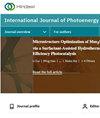集成机器学习和统计分析方法在智慧城市中的太阳能发电
IF 2.1
4区 工程技术
Q3 CHEMISTRY, PHYSICAL
引用次数: 2
摘要
目前,光伏发电系统是可再生能源发展的重要组成部分。由于太阳能生产对气候变化的固有依赖性,利用天气数据预测电力生产具有许多经济优势,包括可靠的主动电力交易和运营计划。特大城市发电被认为是城市管理的现代特征的一个当前研究问题,特别是在发展中国家,如伊朗。机器学习可用于识别可再生资源,如转型参与(TP)和光伏(PV)技术;智慧城市概念以居民激励策略为基础,为都市圈供电提供了革命性的建议。可持续发展议程与这一方针同时提出。因此,本文的目标是利用机器学习技术估计伊朗马什哈德的电力需求,并根据专家的专业知识提出激励人们生产可再生能源的创新建议。然后,我们在伊朗马什哈德的研究中,使用太阳能光伏建模工具评估了太阳能在一年内的潜力。本研究采用线性回归技术,利用人工神经网络(ANN)进行预测。在确定太阳能发电装置的安装规模时,最重要的因素是日平均太阳辐照量。太阳能电池板产生的电量可以用某一特定点的平均太阳辐照度来估算。还可以使用精确的预测来确定系统的复杂性、投资回报(ROI)和系统负载度量。几种回归技术和与太阳辐照度有关的指标结合起来,以每平方米千瓦时为单位预测平均太阳辐照度。结果表明,方位角和天顶角因素显著提高了模型的性能。研究结果表明,人工神经网络模型预测夏季和冬季用电量的可靠性为99.9%。因此,在最热和最冷的时期,最大的电力需求可以通过使用光伏系统的可再生能源预测来管理。本文章由计算机程序翻译,如有差异,请以英文原文为准。
Solar Power Generation in Smart Cities Using an Integrated Machine Learning and Statistical Analysis Methods
Presently, photovoltaic systems are an essential part of the development of renewable energy. Due to the inherent dependence of solar energy production on climate variations, forecasting power production using weather data has a number of financial advantages, including dependable proactive power trading and operation planning. Megacity electricity generation is regarded as a current research problem in the modern features of urban administration, particularly in developing nations such as Iran. Machine learning could be used to identify renewable resources like transformational participation (TP) and photovoltaic (PV) technology; based on resident motivational strategies, the smart city concept offers a revolutionary suggestion for supplying power in a metropolitan region. The sustainable development agenda is introduced at the same time as this approach. Therefore, the article’s goals are to estimate Mashhad, Iran’s electrical power needs using machine learning technologies and to make innovative suggestions for motivating people to generate renewable energy based on the expertise of experts. The potential of solar power over the course of a year is then assessed in our research study in Mashhad, Iran, using the solar photovoltaic modelling tool. The present idea in this research uses linear regression techniques to forecast utilising artificial neural networks (ANN). The most important factor in sizing the installation of solar power producing units is the daily mean sun irradiation. The amount of power that will be produced by solar panels can be estimated using the mean sun irradiance at a particular spot. A precise prediction can also be used to determine the complexity of the system, return on investment (ROI), and system load metrics. Several regression techniques and solar irradiance-related metrics have been combined to forecast the mean sun irradiation in terms of kilowatt hours per square metre. Azimuth and zenith factors considerably enhance the performance of the model, as demonstrated by the proposed method. The results of this study demonstrate 99.9% reliability rate for ANN model prediction of the electrical power usage during the summer and winter seasons. Thus, the maximum of power requirement during the hottest and coolest periods can be managed by using the photovoltaic system’s renewable power projections.
求助全文
通过发布文献求助,成功后即可免费获取论文全文。
去求助
来源期刊
CiteScore
6.00
自引率
3.10%
发文量
128
审稿时长
3.6 months
期刊介绍:
International Journal of Photoenergy is a peer-reviewed, open access journal that publishes original research articles as well as review articles in all areas of photoenergy. The journal consolidates research activities in photochemistry and solar energy utilization into a single and unique forum for discussing and sharing knowledge.
The journal covers the following topics and applications:
- Photocatalysis
- Photostability and Toxicity of Drugs and UV-Photoprotection
- Solar Energy
- Artificial Light Harvesting Systems
- Photomedicine
- Photo Nanosystems
- Nano Tools for Solar Energy and Photochemistry
- Solar Chemistry
- Photochromism
- Organic Light-Emitting Diodes
- PV Systems
- Nano Structured Solar Cells

 求助内容:
求助内容: 应助结果提醒方式:
应助结果提醒方式:


